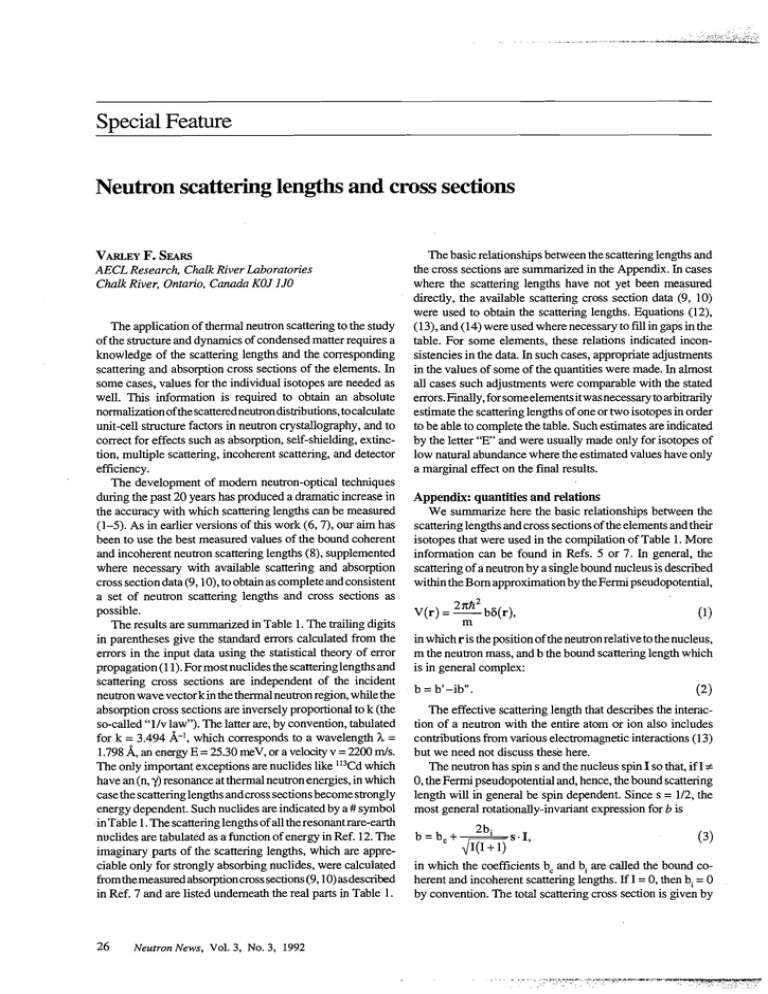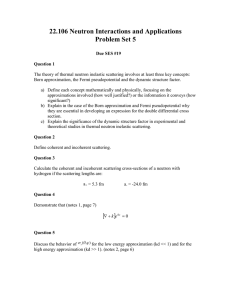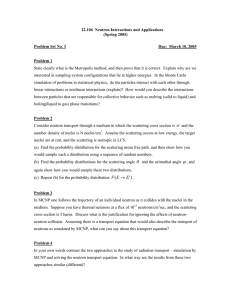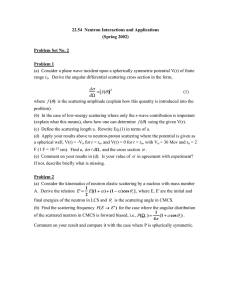Neutron scattering lengths and cross sections (PDF
advertisement

Special Feature Neutron scattering lengths and cross sectioirn VARLEY F. SEARS AECL Research, Chalk River Laboratories Chalk River, Ontario, Canada KOJ l JO The application of thermal neutron scattering to the study of the structure and dynamics of condensed matter requires a knowledge of the scattering lengths and the corresponding scattering and absorption cross sections of the elements. In some cases, values for the individual isotopes are needed as well. This information is required to obtain an absolute normalizationof the scatteredneutrondistributions,tocalculate unit-cell structure factors in neutron crystallography, and to correct for effects such as absorption, self-shielding, extinction, multiple scattering, incoherent scattering, and detector efficiency. The development of modem neutron-optical techniques during the past 20 years has produced a dramatic increase in the accuracy with which scattering lengths can be measured (1-5). As in earlier versions of this work (6,7), our aim has been to use the best measured values of the bound coherent and incoherent neutron scattering lengths (g), supplemented where necessary with available scattering and absorption cross section data (9,10), to obtain as completeand consistent a set of neutron scattering lengths and cross sections as possible. The results are summarized in Table 1. The trailing digits in parentheses give the standard errors calculated from the errors in the input data using the statistical theory of error propagation (11).For most nuclides the scatteringlengths and scattering cross sections are independent of the incident neutron wave vector kin the thermal neutron region, whilethe absorption cross sections are inversely proportional to k (the so-called "llv law"). The latter are, by convention, tabulated for k = 3.494 A--',which corresponds to a wavelength h = 1.798 A, an energy E = 25.30 meV, or a velocity v = 2200 mls. The only important exceptions are nuclides like Il3Cdwhich have an (n, y) resonance at thermal neutron energies,in which casethe scattering lengths and cross sectionsbecome strongly energy dependent. Such nuclides are indicated by a # symbol inTable 1.The scatteringlengthsof all theresonant rare-earth nuclides are tabulated as a function of energy in Ref. 12. The imaginary parts of the scattering lengths, which are appreciable only for strongly absorbing nuclides, were calculated fiomthemeasured absorption cross sections(9,lO) asdescribed in Ref. 7 and are listed underneath the real parts in Table 1. 26 Neutron News, Vol. 3, NO.3, 1992 The basic relationshipsbetween the scatteringlen,as and the cross sections are summarized in the Appendix. In cases where the scattering lengths have not yet been measured directly, the available scattering cross section data (9, 10) were used to obtain the scattering lengths. Equations (12), (13), and (14) were used where necessary to fill in gaps in the table. For some elements, these relations indicated inconsistencies in the data. In such cases, appropriate adjustments in the values of some of the quantities were made. In almost all cases such adjustments were comparable with the stated errors.Finally,for someelementsitwas necessary to arbitrarily estimate the scattering lengths of one or two isotopes in order to be able to complete the table. Such estimates are indicated by the letter "E" and were usually made only for isotopes of low natural abundance where the estimated values have only a marginal effect on the final results. Appendix: quantities and relations We summarize here the basic relationships between the scattering lengths and cross sections of the elements andtheir isotopes that were used in the compilation of Table 1. More information can be found in Refs. 5 or 7. In general, the scattering of a neutron by a single bound nucleus is described within the Born approximationby the Fermi pseudopotential, in which r is the position of the neutron relative to the nucleus, m the neutron mass, and b the bound scatteringlength which is in general complex: The effective scattering length that describes the interaction of a neutron with the entire atom or ion also includes contributions from various electromagneticinteractions (13) but we need not discuss these here. The neutron has spin s and the nucleus spin I so that, if I $ 0, the Fermi pseudopotentialand, hence, the bound scattering length will in general be spin dependent. Since s = 112, the most general rotationally-invariant expression for b is in which the coefficients bc and bi are called the bound coherent and incoherent scattering lengths. If I = 0, then bi = 0 by convention. The total scattering cross section is given by S~ecialFeature 0, = 4n(lb12), (4) in which the brackets denote a statistical average over the neutron and nuclear spins, and the absorption cross section is given by then: bc = C clbcl, 1 OS = C CloSl7 1 4n o, = -(b") ' k where k is the incident-neutron wave vector. If the neutron or the nucleus is unpolarized then the total scattering cross section is of the form 2 +oi, (6) 0, = GC in which ocand q are called the bound coherent and incoherent scattering cross sections: 2 o, = 4nIbcl2,oi= 4nlbil , (7) " C ' =4nlbcl (15) 7 and the bound incoherent scatteringcross sectionis definedas oi =Gs-GC. (16) Hence, it follows that 2 (8) The absorptioncross sectionis thereforeuniquely determined by the imaginary part of the bound coherent scattering length. It is only when the neutron and the nucleus are both polarized that the imaginary part of the bound incoherent scattering length contributes to the value of oa. Apart from some minor "local field" corrections (5, 14), the index of refraction n is given by the relation n 2 = 1--4n (b), k2 P where p is the number of atoms per unit volume. For unpolarized neutrons, (b) = b,. 0. oi = 4nlbi( = oi(spin)+ oi(isotope), and the absorption cross section is given by o a = -4n b k The bound coherent scatteringcross section of the mixture is given, as before, by (10) If the neutrons and the nuclei are both polarized then (b) depends on bi as well as bc.Equation (9) is the basic relation that enables one to determine scattering lengths (both magnitude and sign) from neutron optical measurements. The coefficients bc and bi in the expression (3) for the bound scattering length depend on the particular isotope under consideration,and this provides an additional sourceof incoherence in the scattering of neutrons by a mixture of isotopes. If the brackets are now taken to denote an average over both the spin and the isotope distributions, then the expressions (10) for bc, (4) for q,and (5) for oaalso apply to a mixture of isotopes. Hence, if c, is the mole fraction of isotopes of type 1, so that (17) in which the contribution from spin incoherence is given by and that from isotope incoherence is Note thatfor a mixture of isotopes only the magnitude of bi is defined by Eq. (17), and its sign is arbitrary. However, for each individual isotope, both the magnitude and sign (or complex phase) of biare defined in the expression (3). Acknowledgments The author is grateful to L. Koester, H. Rauch and E. Seymann, whose recent survey (8)of all measured neutron scattering lengths up to the end of December 1990 was of great help in ensuring that the present compilation was as up to date as possible. We also thank Professor Rauch for sending us information on some more recently measured values. Professor W. Waschkowskifor keeping us abreast of the work at Munich, and Dr. K. Guckelsberger for his critique of the available He data. References 1. L. Koester, Neutron ScatteringLengths and Fundamental Neutron Interactions, Springer Tracts Mod. Phys. 80, 1 (1977). 2. A.G. Klein and S.A. Werner, Neutron Optics, Rep. Prog. Phys. 46,259 (1983). 3. S.A. Werner and A.G. Klein, Neutron Optics, in: Methods of Experimental Physics, Vol. 23 -Neutron Scattering, Part A, edited by K. Skij1dandD.L. Price (Academic Press, New York, 1986), p. 259. 4. H. Glattli and M. Goldman, Nuclear Magnetism, in: Methods of ExperimentalPhysics, Vol. 23 -Neutron Scattering,Part C, Vol. 3, No. 3. 1992, Neutron News 27 Special Feature 5. 6. 7. 8. 28 edited by K. Skold and D.L. Price (AcademicPress. New York, 1987), p. 241. V.F. Sears, Neutron Optics (Oxford University Press, Oxford, 1989). V.F. Sears, Thermal-Neutron Scattering Lengths and Cross Sections for Condensed-Matter Research, Atomic Energy of Canada Limited Report AECL-8490, June 1984. V.F. Sears, Neutron Scattering Lengths and Cross Sections, in: Methods of ExperimentalPhysics, Vol. 23 -Neutron Scattering, Part A, edited by K. Skold and D.L. Price (AcademicPress, New York, 1986), p. 521. L. Koester, H. Rauch, and E. Seymann, Neutron Scattering Lengths: a Survey of Experimental Data and Methods, Atomic Data and Nuclear Data Tables, 49,65 (1991). Neutron News, Vol. 3, No. 3, 1992 9. S.F. Mughabghab,M. Divadeenam, and N.E. Holden, Neutron Cross Sections,Vol. 1,Part A: Z= 1-60 (AcademicPress, New York, 1981). 10. S.F. Mughabghab, Neutron Cross Sections, Vol. 1, Part B: Z = 61 - 100 (Academic Press, New York, 1984). 11. H.D. Young, Statistical Treatment of Experimental Data (McGraw-Hill, New York, 1962). 12. J.E. Lynn and P.A. Seeger, Resonance Effects in Neutron Scattering Lengths of Rare-Earth Nuclides, Atomic Data and Nuclear Data Tables, 44, 191 (1990). 13. V.F. Sears, Electromagnetic Neutron-Atom Interactions,Phys. Rep. 141,281 (1986). 14. V.F. Sears, Local-Field Refinement of Neutron Scattering Lengths, Z. Phys. A 321,443 (1985). S~ecialFeature Table 1. Neutron scattering lengths and cross sections of the elements and their isotopes. Column 1 2 3 4 5 6 7 8 9 10 11 Symbol Unit % fm fm barn1 barn barn barn Quantity element atomic number mass number spin (parity) of the nuclear ground state natural abundance (For radioisotopes the half-life is given instead.) bound coherent scattering length bound incoherent scattering length bound coherent scattering cross section bound incoherent scattering cross section total bound scattering cross section absorption cross section for 2200 m/s neutrons2 Vol. 3, No. 3, 1992, Neutron News 29 Special Feature 30 Neutron News, Vol. 3, NO.3, 1992 Special Feature Vol. 3, No. 3, 1992, Neutron News 31 Special Feature 32 Neutron News, Vol. 3, No. 3, 1992 S~ecialFeature Vol. 3, No. 3, 1992. Neutron News 33 S~ecialFeature 25.(1l.) 3.1(8) 11.(2.) 34 Neutron News, Vol. 3, No. 3, 1992 S~ecialFeature Vol. 3, No. 3, 1992, Neutron News 35 Special Feature 36 Neutron News, Vol. 3, NO. 3, 1992 Special Feature Vol. 3, No. 3, 1992, Neutron News 37







